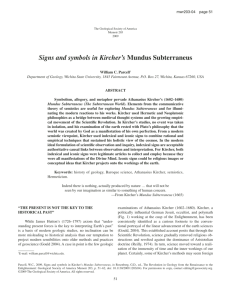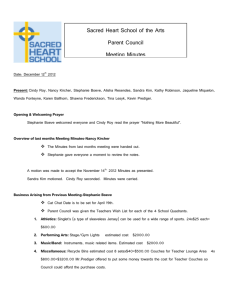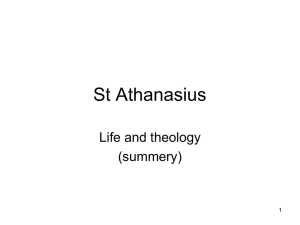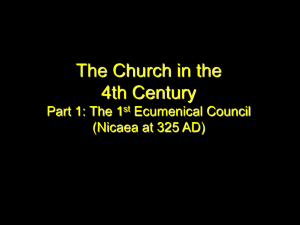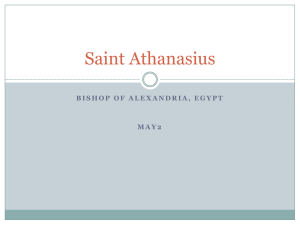Glomski, “Religion, the Cosmos, and Counter
advertisement
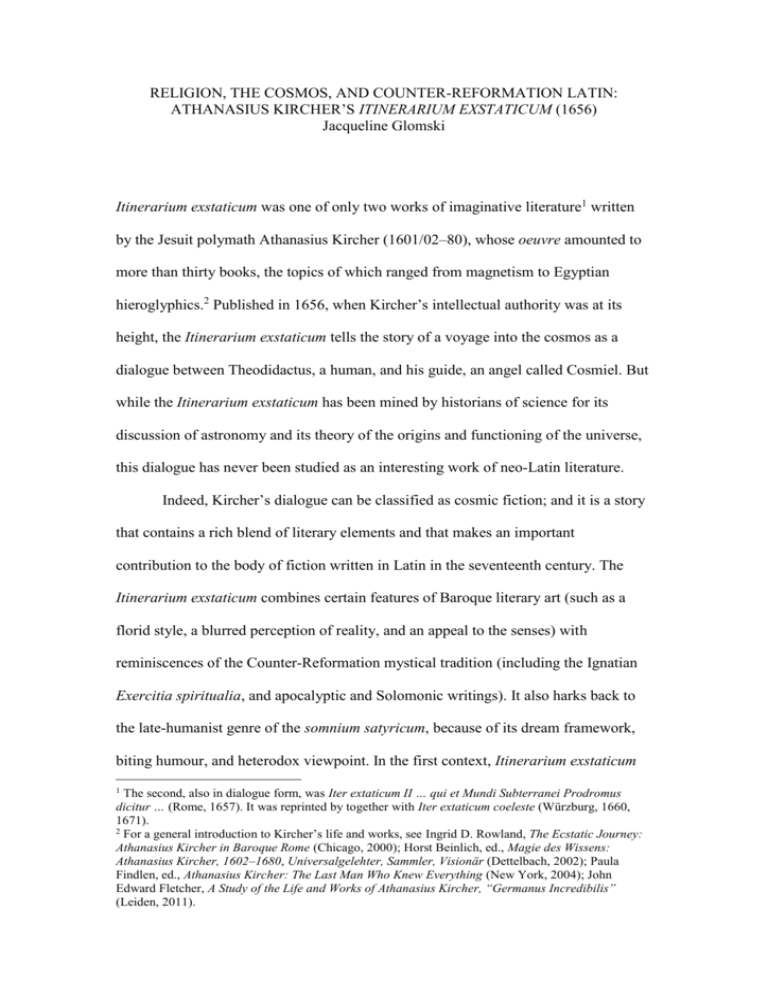
RELIGION, THE COSMOS, AND COUNTER-REFORMATION LATIN: ATHANASIUS KIRCHER’S ITINERARIUM EXSTATICUM (1656) Jacqueline Glomski Itinerarium exstaticum was one of only two works of imaginative literature1 written by the Jesuit polymath Athanasius Kircher (1601/02–80), whose oeuvre amounted to more than thirty books, the topics of which ranged from magnetism to Egyptian hieroglyphics.2 Published in 1656, when Kircher’s intellectual authority was at its height, the Itinerarium exstaticum tells the story of a voyage into the cosmos as a dialogue between Theodidactus, a human, and his guide, an angel called Cosmiel. But while the Itinerarium exstaticum has been mined by historians of science for its discussion of astronomy and its theory of the origins and functioning of the universe, this dialogue has never been studied as an interesting work of neo-Latin literature. Indeed, Kircher’s dialogue can be classified as cosmic fiction; and it is a story that contains a rich blend of literary elements and that makes an important contribution to the body of fiction written in Latin in the seventeenth century. The Itinerarium exstaticum combines certain features of Baroque literary art (such as a florid style, a blurred perception of reality, and an appeal to the senses) with reminiscences of the Counter-Reformation mystical tradition (including the Ignatian Exercitia spiritualia, and apocalyptic and Solomonic writings). It also harks back to the late-humanist genre of the somnium satyricum, because of its dream framework, biting humour, and heterodox viewpoint. In the first context, Itinerarium exstaticum The second, also in dialogue form, was Iter extaticum II … qui et Mundi Subterranei Prodromus dicitur … (Rome, 1657). It was reprinted by together with Iter extaticum coeleste (Würzburg, 1660, 1671). 2 For a general introduction to Kircher’s life and works, see Ingrid D. Rowland, The Ecstatic Journey: Athanasius Kircher in Baroque Rome (Chicago, 2000); Horst Beinlich, ed., Magie des Wissens: Athanasius Kircher, 1602–1680, Universalgelehter, Sammler, Visionär (Dettelbach, 2002); Paula Findlen, ed., Athanasius Kircher: The Last Man Who Knew Everything (New York, 2004); John Edward Fletcher, A Study of the Life and Works of Athanasius Kircher, “Germanus Incredibilis” (Leiden, 2011). 1 Glomski, “Religion, the Cosmos, and Counter-Reformation Latin” - 2 connects neo-Latin literature to the vernacular writing of the Baroque; and in the second, it points to the continuity and strength of neo-Latin traditions begun in the late sixteenth century. Kircher published his Itinerarium at Rome, where he was attached to the Jesuit College. At this time, Kircher, who has been labelled “The Last Man Who Knew Everything,”3 was already well known for his encyclopedic works. In his Magnes (Rome, 1641), Kircher had denounced the theories of Copernicus and Kepler, and he had refused to write more on cosmology. It is not known exactly why he changed his mind; perhaps it was at the insistence of his disciple Kaspar Schott (who claimed in the second edition of the Itinerarium that he had given Kircher the idea for the book), or at the insistence of the recently elected Pope Alexander VII, a friend of Kircher’s.4 Kircher himself, in the preface to the Itinerarium, mentioned the encouragement of the emperor Ferdinand III.5 In any case, Itinerarium exstaticum was dedicated to Queen Christina of Sweden who had recently given up her throne and converted to Catholicism, and Kircher’s book can be seen as part of the Jesuit campaign to introduce her to the Roman intellectual scene and to gain, publicly, her approval.6 The book was ready, having passed through the Jesuit censors, just in time for Christina’s entry into the Vatican in November 1655. Itinerarium exstaticum is a 288-page trip through the cosmos, written in dialogue form and focussing on cosmological theory. It is followed by Itinerarii See Paula Findlen, “The Last Man Who Knew Everything … or Did He? Athanasius Kircher, S.J. (1602–80) and His World,” in Athanasius Kircher, ed. Paula Findlen (see above, n. 2), 1–48. 4 Athanasii Kircheri Iter extaticum coeleste, praelusionibus et scholiis illustratum a P. Gaspare Schotto (Würzburg, 1660), 3–5. Alexander VII had assisted in the publication of Kircher’s Oedipus Aegyptiacus (1652–55), a four-volume work on Egyptology. Harald Siebert, Die große kosmologische Kontroverse. Rekonstruktionsversuche anhand des Itinerarium exstaticum von Athanasius Kircher SJ (1602–1680) (Stuttgart, 2006), 39; Ingrid D. Rowland, “Athanasius Kircher, Giordano Bruno, and the Panspermia of the Infinite Universe,” in Athanasius Kircher, ed. Paula Findlen (see above, n. 2), 192. 5 Athanasius Kircher, Itinerarium exstaticum (Rome, 1656) (hereafter cited as Itinerarium exstaticum), 4. 6 Siebert, Die große kosmologische Kontroverse (see above, n. 4), 18–21. 3 Glomski, “Religion, the Cosmos, and Counter-Reformation Latin” - 3 exstatici dialogus II, which continues for another 173 pages, but which leaves off the narrative and consists of an essay in dialogue form, considering such topics as the creation and magnitude of the universe, and the order, placement and distance of the heavenly bodies while simply expanding upon the theory presented in the first part of the work. Only the first part, which contains the fictional storyline, is relevant here. The narrator, Theodidactus, falls asleep after an evening concert at the Jesuit College and dreams that he is lying in a verdant meadow, where he is visited by an angel, Cosmiel, who offers to escort him through the heavens. Theodidactus accepts and is taken up into the sky folded in the wings of the angel to begin a voyage to the moon and to each of the planets, and then out to the stars. The account of the journey is told as a combination of formal dialogue, with explicit speaking parts for both characters, and first person narration and description from the point of view of Theodidactus. The relationship between Theodidactus and his adept guide is humorous; Kircher takes advantage of the neophyte’s limited knowledge to grumble about philosophers who cling to Aristotelianism. Kircher’s dialogue exhibits certain characteristics of the Baroque: his style is florid; his paragraphs are laced with expressions of piety and mysticism; his narrative, placed in the framework of a dream, blurs the perception of reality. Historians of science have been interested in Itinerarium exstaticum for its role in the seventeenth-century controversy over Copernicanism.7 Although, in his preface to the reader, Kircher wrote that his book was an effort to address recent astronomical discoveries and that he had composed it in dialogue form to make it more enjoyable,8 7 Siebert, Die große kosmologische Kontroverse (see above, n. 4) describes in detail the role of Kircher’s book in the controversy. 8 Itinerarium exstaticum (see above, n. 5), 4–5: “Hic itaque novus mundi apparatus ac inaudita lascivientis naturae feracitas, tametsi omnium in sese astronomorum oculos attraxerit, dici tamen vix potest quantum tam insolentium effectuum causae nullius non ingenium torserint. Et uti rerum insolitarum rumores omnium aures mirum in modum vellicant, ita non mathematicos tantum et Glomski, “Religion, the Cosmos, and Counter-Reformation Latin” - 4 Kircher’s encyclopedic methods and synthetic approach, as well as the bold authority with which he wrote, launched the Itinerarium into the battle. So, although Kircher had meant his work as an allegorical story,9 it was enlarged into a cosmological treatise by Kaspar Schott, who republished it as Iter extaticum coeleste in Würzburg in 1660 (reprinted in 1671).10 At the end of the century, Kircher’s work prompted the Dutch scientist Christiaan Huygens to write his own essay on a voyage through the cosmos, Cosmotheoros (Hague, 1698), in which he criticized Kircher for not having the courage to publish his true thoughts.11 Of course, as a Jesuit, Kircher could not have supported the Copernican system in his publications, even if he might have done so in private.12 In his book, Kircher took as his starting point Tycho Brahe’s system of the universe that was the official Jesuit cosmology. Then, he went on to reject blatantly the theories of the ancient philosophers in favour of the observations of contemporary philosophos, sed et principum curiositatem anxie exstimulavit. … ut iucundius amoeniusque in legentium animos influeret, in dialogi formam concinnare visum fuit, Exstatici Itinerarii nomine indigitatum ….” 9 Ibid., 6: “Finis itaque et unica suscepti operis intentio fuit, eam in hoc libello sectari methodum quam iam olim ex veteribus, Trismegistus, Plato, Lucianus, et ex succedentibus saeculis, complures tum poetae tum oratores laudabili sane consuetudine tenuerunt; methodum, inquam, quam iucundum, amoenum, et ad lectoris gustum accommodatum dicendi genus ornaret, allegorica vero enarrationum involucra veluti lucem, coloremque, umbratiles linearum ductus suaviter contemperarent, thaumaturgicae quoque stylo poetico descriptae operationes, lectoris animum pruritu quodam sollicitatum ad propositarum rerum ponderationem suaviori impetu raperent ….” 10 Siebert, Die große kosmologische Kontroverse (see above, n. 4), 13, 21–2. 11 As noted by Paula Findlen, “The Last Man Who Knew Everything … or Did He?” (see above, n. 3), 8. John E. Fletcher, in his article “Astronomy in the Life and Correspondence of Athanasius Kircher,” Isis 61 (1970), 52–67, notes that the Itinerarium was the least discussed of Kircher’s works in the corpus of his correspondence (59). Fletcher (58, 67) mentions a letter to Kircher from Father Francisco Ximénez, a missionary in Mexico, praising the work (20 April 1661) and a letter from Kircher to Hevelius (8 May 1665) in which he refers to the Itinerarium, dismissing attacks on it. Kircher’s Itinerarium also may have inspired Valentin Stansel’s Uranophilus (Ghent, 1685), according to Carlos Ziller Camenietzki, “Baroque Science between the Old and the New World,” in Athanasius Kircher, ed. Paula Findlen (see above, n. 2), 311–28. 12 Rowland, “Athanasius Kircher, Giordano Bruno, and the Panspermia” (see above, n. 4), 191. In their article, “The Partial Acceptance of the Copernican Theory of A. Kircher,” Journal of the Royal Astronomical Society of Canada 67 (1973): 311–7, A. E. Covington and T. R. Robinson note that Kircher’s book Ars magna lucis et umbrae (Rome, 1646; Amsterdam, 1671) contains an illustration of the solar system that has the sun in the centre of a circle of planets, but that this is used as an abstraction to show Copernican theory through the shadows cast by the planets around the sun; Kircher in no way advocates Copernicanism in the book, which was passed by the Jesuit censors. Glomski, “Religion, the Cosmos, and Counter-Reformation Latin” - 5 astronomers.13 So, Cosmiel states that the moon, like all the other heavenly bodies, is made of four elements and not five, “as the Peripatetics say.” And, Theodidactus asserts that the ancient philosophers “wandered from the truth” when talking about the crystalline spheres; “today, with the telescope, astronomers have penetrated the innermost parts of the heavenly bodies,” with Cosmiel responding that “philosophers are unable to conclude anything about the composition of the universe by insisting on their thoughts alone and rejecting experiments.”14 But, Kircher really played with heresy by borrowing ideas from the theories of Giordano Bruno and Nicholas of Cusa, such as panspermia – a quality carried on the liquid fire by which the sun’s rays penetrated liquid space to reach the Earth’s surface – and the proposition of an infinite universe.15 In the discussion of Kircher’s ideas on the cosmos, the literary aspect of Kircher’s Itinerarium exstaticum has largely been overlooked; only vague remarks Kircher relied on Galileo’s discoveries of the moon’s surface, the four moons of Jupiter, the phases of Venus and thus its orbit around the sun, as well as the tri-bodied shape of Saturn, the rings of which had not yet been identified. The rich detail in which moonscape is described in the conversation of Theodidactus and Cosmiel was probably inspired by Hevelius’s maps of the moon. The dialogue also drew on Christoph Scheiner’s observations of sunspots. Harald Siebert, “Kircher und die Astronomie,” in Magie des Wissens, ed. Horst Beinlich (see above, n. 2), 186–7. 14 Itinerarium exstaticum (see above, n.5), 51, 55–6: “[Cosmiel:] … sciendum est totum lunarem globum, uti et omnia alia mundi corpora coelestia, non secus ac terrestre corpus, ex quatuor elementis compositum esse, neque ullam, uti Peripatetici sibi fingunt, quintam essentiam in mundo reperiri …. ” “[Theodidactus:] … [I]am video quantum plerique Philosophi a veritate olim aberrarint dum post sphaeram ignis intra lunae concavum positam, omnes supra eam dispositas ordine sphaeras coelestes, veluti ex cristallina quadam soliditate constitutas esse affirmarunt …; his enim omnia contraria deprehendunt hodie astronomi, qui miro illo tubi optici organo, corporum coelestium adyta penetrarunt …. Cosmiel: Sic est fili mi; fieri enim non potest ut philosophi solis suis cogitatis insistentes, repudiatisque experientiis quidquam solidi circa naturalem mundi constitutionem concludere possint.” 15 Rowland, “Athanasius Kircher, Giordano Bruno, and the Panspermia” (see above, n. 4), 194–5, 197– 8. She explains, “Fertility, in other words, was projected light and heat on the rays of the Sun” (195). She supposes that Kircher had read Bruno’s poem, De immenso et innumerabilibus (1591), in which Bruno describes “an infinite cosmos composed of hot stars orbited by colder planets” and claims that “the infinite universe carried the seeds of its own propagation everywhere” (197). See also Carlos Ziller Camenietzki, “L’infini dans la pensée d’Athanasius Kircher S.J.,” in Infini des philosophes, infini des astronomes, ed. Françoise Monnoyeur (Paris, 1995), 61–76. Kircher elaborates on Cusanus’s theory in the second part of Itinerarium exstaticum. See Carlos Ziller Camenietzki, “L’extase interplanetaire d’Athanasius Kircher: Philosophie, cosmologie et discipline dans la Compagnie de Jésus au XVII e siècle,” Nuncius 10 (1995), 3–32, there 18–20. For a summary of Kircher’s ideas on nature and the universe, and their theological grounding, see Thomas Leinkauf, Mundus combinatus. Studien zur Struktur der barocken Universalwissenschaft am Beispiel Athanasius Kirchers SJ (1602–1680) (Berlin, 1993). 13 Glomski, “Religion, the Cosmos, and Counter-Reformation Latin” - 6 have been made.16 Ingrid Rowland has suggested that the Itinerarium is not simply a Christian version of Cicero’s Somnium Scipionis, but an amatory pilgrimage in the spirit of Dante’s Divine Comedy, with the angel Cosmiel (serving as Beatrice) addressed by Theodidactus in the tones of the Biblical Song of Songs. More interestingly, Rowland also notes that Kircher’s representation of the heavens possesses “all the imaginative precision of a longtime practitioner of Ignatius Loyola’s Spiritual Exercises.” 17 Without a doubt, the literature of the sixteenth-century Catholic mystics had an impact on Kircher’s composition. In his introduction, Kircher even declares that Theodidactus acts in the manner of the mystics.18 Besides showing an influence of Loyola, Kircher’s language resembles that of Teresa of Avila and John of the Cross, who sprinkled their meditational works with quotations from the Song of Songs. Moreover, Kircher quotes from the Psalms, and from the Solomonic-related Ecclesiastes and Ecclesiasticus.19 Kircher’s inspiration for Theodidacticus’s angelic guide and the angelic beings met along the voyage, as well as for his depiction of the planets, comes most likely from the Book of Enoch.20 As a result, Itinerarium Kircher’s story has been acknowledged as an early work of science fiction: Siebert, Die große kosmologische Kontroverse (see above, n. 4), 49, states that before Kircher’s work there were only two works of science fiction – Kepler’s Somnium and Francis Godwin’s Man in the Moon (Siebert was obviously unaware of Libert Froidmont’s Somnium sive peregrinatio caelestis). 17 Rowland, “Athanasius Kircher, Giordano Bruno, and the Panspermia” (see above, n. 4), 193. Rowland, The Ecstatic Journey (see above, n.2), 77, gives an example of Kircher quoting the Song of Songs (3.2, 3.4) “Hisce excitatus dixi in corde meo, surgam et circumibo coelestis civitatis vicos et plateas, quaeram quem diligit anima mea, ut in operibus suis inventum teneam, nec dimittam” (Itinerarium exstaticum, 31–2). 18 Itinerarium exstaticum (see above, n. 5), 7: “Hinc ascetarum more Theodidactus post maxima sapientissimi Conditoris opera in divini amoris actus, atque in admirationis affectus raptus, nihil aliud intendit quam ut lectorem ad similes Deo debitas gratiarum actiones … concitet.” 19 For example, Kircher quotes Ecclesiastes 1.5, 3.11; Ecclesiasticus 11.4, 42.17, 43.34, 43.36; Psalm 45.9. Ibid., 31, 149, 229. 20 A modern translation is The Book of Enoch or Enoch I: A New English Edition, ed. and trans. Matthew Black (Leiden, 1985). See especially Chapters 17–36, “Enoch’s Journeys.” Kircher mentioned in his Oedipus Aegyptiacus. Tomus secundus. Pars prima (Rome, 1653), 68, that he had been able to consult a fragment of Enoch in the Greek library of the monastery of San Salvatore in Messina in 1637. On the use of angel guides in apocalyptic literature, see Valery Rees, From Gabriel to Lucifer: A Cultural History of Angels (London, 2013), Chapter 9. I thank Valery Rees for suggesting 16 Glomski, “Religion, the Cosmos, and Counter-Reformation Latin” - 7 exstaticum reads very much like a meditation on the glory of God as revealed in the marvels of His creation. But, for as much as the journey is expressed in the manner of a mystic, Kircher maintains in his introduction to the reader that his Itinerarium is a work of fiction – a fiction that is to communicate certain facts and information – and not an epiphany or divine revelation.21 Kircher’s original combination of mysticism and fiction is characterized first of all by the essential role of angels as characters in moving the narrative along and imparting mood to the story. The main actor in the story is Cosmiel, the angel guide, who is described as a man of unusual nature: his head and his face shine with brightness; his red eyes glow; the feathers of his wings display every colour; his hands and feet surpass jewels; his right hand holds a globe depicting the wandering stars, made of precious stones of varying colours; his left hand holds a measuring stick made with jewelled artifice.22 It is Cosmiel who fuels the journey, physically moving Theodidactus from place to place, either by wrapping his neophyte charge in his wings and carrying him up or by providing him with some other supernatural means of transport and protection from the harsh elements of the cosmos.23 While it is Theodidactus who starts off each episode by asking a question, it is Cosmiel who that I investigate the Book of Enoch and for making material from her book available to me in advance of publication. 21 Itinerarium exstaticum (see above, n.5), 6–7: “Nullum itaque hic mysterium, nullum raptum aut divini numinis revelationem, nullam epiphaniam angelicam, nullum Oraculi Delphici afflatum subesse velim; sed ut omnia luculenter demonstrarentur, ratiociniaque de rebus adeo incognitis suavius lectoris animo ingererentur, sub ingeniosi figmenti velamine seu ficti raptus integumento exhibita esse lector sibi persuadeat velim.” 22 Ibid., 35: “Et protinus mihi insolitae constitutionis vir adstitit, caput eius faciesque miro quodam fulgebat iubare, oculi carbunculorum instar coruscabant, habitus totius corporis exotico et inviso hucusque vestimento constituebatur; siquidem admiranda quadam in formam alarum complicatarum textura ita adornabatur ut nullum fere colorum genus quod pennae eius non exprimerent concipi aut animo fingi posset; manus pedesque omnem lapidum pretiosorum nitorem superabant, dextra sphaeram gestabat, in qua quot vagantium siderum orbes, tot ex lapidibus pretiosis diversi coloris sphaerulae eidem insertae spectabantur: mirum visu opus; sinistra mensorium baculum gemmeo artificio apprime elaboratum et mira arte distributum ferebat.” 23 For example, Cosmiel pours a vial of heavenly dew over Theodidactus to protect him from the fiery heat of the sun, and when they descend to the sun’s surface, Theodidactus provides a boat made of asbestos. Ibid., 122–3. Glomski, “Religion, the Cosmos, and Counter-Reformation Latin” - 8 mouths the theories that Kircher wishes to expound, and it is Cosmiel who sets the destinations, from planet to planet. Aside from Cosmiel, each planet – and the sun – has its own guardian angel who symbolizes the nature of the heavenly body he watches over.24 The crystalline planet Venus harbours a chorus of beautiful youths, with golden hair flowing around their shoulders, their eyes and faces filled with loveliness and grace, wearing elegant clothes made of crystal, with cymbals and lyres, and baskets of roses and lilies, hyacinths and narcissi in their hands. On Mercury, there flies down a man with a crown on his head, his face seemingly breathing wisdom; he sports a golden beard, and has wings on his shoulders and feet. Unsurprisingly, he carries a caduceus in his right hand and a set of pan-pipes in his left. On the sun, Theodidactus witnesses angels who breathe heat and beat their wings above a rainbow of colours; their splendour is impossible to describe: these are the Seraphim, who look upon the face of God without interruption. On Mars, Theodidactus is terrified by a crowd of fiery horsemen, who carry a fiery sword in one hand and a fiery whip in the other; they vomit forth flames in all directions; they shoot out fiery rays with their eyes. And so on … out to the stars.25 Kircher’s fiction, in its description of natural and supernatural phenomena, appeals to all five senses, in a manner typical of Baroque aesthetics. In Itinerarium exstaticum, the scenes of the voyage to the planets are imbued with mood and colour Ibid., 99–100: “Cosmiel: Sunt veri spiritus omni materialis miscellae conditione expertes; … sunt intelligentiae purissimae semper in actu, Deo ad nutum obtemperantes, sunt denique administratorii spiritus ad eorum qui hereditatem capiunt salutis ministerium destinati.” 25 On Jupiter, he sees a battle-line of men, yet displaying a demeanour of clemency and intelligence, and breathing an odour of sweetness; each is in silvery dress, covered with a magnificent military cloak bordered in gold, and each is carrying in his right hand a sword decorated with all kinds of precious stones and in his left a censer puffing out a thousand fumes of aromatic spices. On Saturn there appears a band of distinguished old men, their faces suffused with a sad and pallid colour, their foreheads rough with wrinkles, their feet taking a slow step. They wear plain black cloaks, with no ornaments; in their right hands they hold an incense-box fuming with black, obnoxious smoke and in the left a sickle. Ibid., 97–8; 116; 182–3; 203; 227; 254. 24 Glomski, “Religion, the Cosmos, and Counter-Reformation Latin” - 9 – on Venus, the odour of musk and amber waft through the air, and the trees seem to rise up out of the blossoming of precious stones;26 Jupiter’s ocean is filled with crystalline water and its mountains and valleys are made of fine silver.27 Kircher invokes not only sight (through images of sparkling jewels and shining metals), but smell (odiferous flowers, angel’s breath, incense and smoke), sound (music and singing, the clanging of arms), and touch (the fiery heat of the sun, the roughness and scaliness of Mars). Kircher’s similes and metaphors are vibrant and striking: when Theodidactus looks up at the sun from Venus, he exclaims that it looks like a cookingpot flowing with liquid copper; on Mars he spots a pitch sea that has the consistency of porridge.28 Such descriptions give Kircher the opportunity to exhibit his repertoire of obscure and exotic Latin vocabulary. And, his verbal darting from discussions of cosmological theory to description of the heavens and to exclamations of ecstasy permits him to display his ability to compose a variety of sentence structures, both simple and compound. But, if Kircher’s Itinerarium is representative of the Baroque, it also shares some of the characteristics of the late-humanist genre of the somnium satyricum, a witty dream harangue that was developed when Justus Lipsius crossed the classical, Ciceronian somnium with Menippean satire in his Satyra Menippaea: Somnium (Antwerp, 1581).29 Lipsius was followed by, among others, the Louvain philosophy Ibid., 96: “Odor huius insulae supra omnia musci et ambrae suffimenta, arbores non quales nostrae, sed ex pretiosorum lapidum efflorescentiis excrevisse videbantur.” 27 Ibid., 209: “Aqueum huius globi elementum tam erat limpidum ut nullam ei chrystalli diaphaneitatem comparari posse censeam; solidiores vero continentis partes, tam immodica luce fulgebant ut et montes et valles non nisi ex argento electo ac splendido constitutas putasses.” 28 Ibid., 96, 198: “Solem intueor veluti ingentem quendam oceanum, veluti cacabum liquefacto cupro undantem”; “O horrorem, o spectaculum formidandum; … piceum mare video, non tamen liquidum sed pultis instar condensatum.” 29 Ingrid De Smet, Menippean Satire and the Republic of Letters 1581–1655 (Geneva, 1996), 87–116. 26 Glomski, “Religion, the Cosmos, and Counter-Reformation Latin” - 10 professor, Libert Froidmont, who published a somnium in 1616 that features a trip into the cosmos and that exhibits some features of the original somnium satyricum. 30 Kircher’s Itinerarium exstaticum, first of all, exploits the ability of the dreamframework of the somnium satyricum to act as a smoke screen to protect an author who vents his irritation with the vices of his contemporaries.31 The guide, always present in the somnium satyricum, even more lessens the responsibility of the satirist by making the insight gained during the voyage appear to be someone else’s initiative. Here, the figure of Cosmiel functions as Kircher’s mouthpiece when he carps at scholars who cling to Aristotelianism. Kircher’s text contains three further characteristics of the somnium satyricum: a sharp use of humour, expressed in the relationship between Theodidactus and Cosmiel, where Cosmiel coddles the earthling throughout their voyage, constantly calming his fears;32 lengthy digressions, with Cosmiel discussing Kircher’s cosmological theories and Theodidactus turning to ecstatic prayer and meditation; and meetings with figures from the ancient world, as Theodidactus comes across the angelic guardians of the planets. If Kircher wanted to conceal his heterodox theories under the smoke screen of Theodidacticus’s dream in Itinerarium exstaticum, then he was successful. In 1672, in his Experimenta nova, the Magdeburg engineer and natural philosopher Otto von On Froidmont, see Jacqueline Glomski, “Science Fiction in the Seventeenth Century: The Neo-Latin somnium and Its Relationship with the Vernacular,” in Der neulateinische Roman als Medium seiner Zeit / The Neo-Latin Novel in Its Time, ed. Stefan Tilg, Isabella Walser (Tübingen, 2013), 41–3. 31 I rely on the definition of the somnium satyricum as given by De Smet (see above, n. 29). 32 When they reach the sun, Theodidactus, marvelling at the incomprehensible greatness of God, declares that he would simply like to die now in order to be able to see Him. Cosmiel responds that that time will come but now they need to make haste on their journey if they are to see the rest of God’s creation, for Theodidactus has yet seen only the most minimal part. “Theodidactus: … Moriatur quaeso anima mea morte iustorum ut eum videam per quem facta sunt omnia et cuius verbo constituuntur omnia. Cosmiel: Necdum tempus advenit, festina parumper, Theodidacte, nec enim vel minimam adhuc operum divinorum particulam contemplatus es.” Itinerarium exstaticum (see above, n. 5), 146. 30 Glomski, “Religion, the Cosmos, and Counter-Reformation Latin” - 11 Guericke suggested that not all of Kircher’s statements in Itinerarium exstaticum were to be taken seriously because, after all, the dialogue was only fiction.33 King’s College London 33 Otto von Guericke, Experimenta nova (Amsterdam, 1672), 238b, as cited by Siebert, Die große kosmologische Kontroverse (see above, n. 4), 105.

